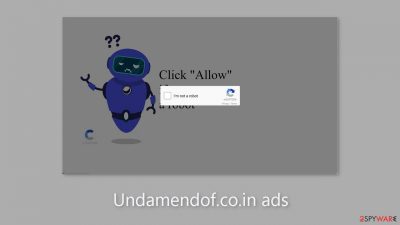Undamendof.co.in ads (fake) - Free Instructions
Undamendof.co.in ads Removal Guide
What is Undamendof.co.in ads?
Undamendof.co.in is a bogus site that was created by crooks to generate revenue

Undamendof.co.in is a deceptive website run by shady people who use social engineering[1] techniques to get people to sign up for push notifications. Users are instructed to click the “Allow” button in order to obtain this membership, ostensibly to verify their status as non-robots. Unfortunately, this results in a flood of spam.
Persistent pop-up ads may still annoy your screen even after you close your browser. These crooks frequently use rogue advertising networks to advertise links to risky websites. Users may unintentionally arrive on websites that are set up to steal their personal data or force them to download potentially unwanted programs (PUPs)[2] or even harmful software.
According to reports from affected users, these ads provide a variety of content, such as adult websites, fake antivirus offerings, software promotions, surveys, and freebies. Therefore, it is crucial to block these adverts right away, especially if numerous users use the impacted device. You can accomplish this by following the detailed instructions provided below.
| NAME | Undamendof.co.in |
| TYPE | Push notification spam; adware |
| SYMPTOMS | Pop-up ads start appearing in the corner of the screen sometimes even when the browser is closed |
| DISTRIBUTION | Shady websites; deceptive ads; bundled software |
| DANGERS | Links embedded in the pop-ups can lead to dangerous websites where people might get tricked into providing their personal information or downloading PUPs and malware |
| ELIMINATION | To disable push notifications go to your browser settings |
| FURTHER STEPS | Use FortectIntego to clear your browsers and fix performance issues |
Distribution methods
News-Lihado.cc, Aroidssolutions.com, News-wonale.cc, and a number of other pop-up spam websites have been covered in our prior guides. You might be wondering where these sites that constantly spam users with push notifications came from. They typically hide out in the shadows of questionable websites.
These websites are well known for displaying questionable adverts and sneaky redirects. Illegal streaming services are a good example because they prominently display fake “Download” and “Play” buttons. These buttons, which purportedly give users access to requested content, instead direct visitors to new pages intended to monetize user interactions.
It's best to only visit websites you know and trust when browsing the internet to protect yourself from being exploited. Avoid clicking on links and advertisements from unknown sources since they could be used as bait by bad actors trying to trick you. It's best to view stuff directly from the original source in order to guarantee your security.

Block push notifications
Because push notifications are based on a subscription model, users need to disable them manually. If you do not know how, here are the instructions for Google Chrome, Mozilla Firefox, Safari, MS Edge:
Google Chrome (desktop):
- Open Google Chrome browser and go to Menu > Settings.
- Scroll down and click on Advanced.
- Locate the Privacy and security section and pick Site Settings > Notifications.
![Stop notifications on Chrome PC 1 Stop notifications on Chrome PC 1]()
- Look at the Allow section and look for a suspicious URL.
- Click the three vertical dots next to it and pick Block. This should remove unwanted notifications from Google Chrome.
![Stop notifications on Chrome PC 2 Stop notifications on Chrome PC 2]()
Google Chrome (Android):
- Open Google Chrome and tap on Settings (three vertical dots).
- Select Notifications.
- Scroll down to Sites section.
- Locate the unwanted URL and toggle the button to the left (Off setting).
![Stop notifications on Chrome Android Stop notifications on Chrome Android]()
Mozilla Firefox:
- Open Mozilla Firefox and go to Menu > Options.
- Click on Privacy & Security section.
- Under Permissions, you should be able to see Notifications. Click Settings button next to it.
![Stop notifications on Mozilla Firefox 1 Stop notifications on Mozilla Firefox 1]()
- In the Settings – Notification Permissions window, click on the drop-down menu by the URL in question.
- Select Block and then click on Save Changes. This should remove unwanted notifications from Mozilla Firefox.
![Stop notifications on Mozilla Firefox 2 Stop notifications on Mozilla Firefox 2]()
Safari:
- Click on Safari > Preferences…
- Go to Websites tab and, under General, select Notifications.
- Select the web address in question, click the drop-down menu and select Deny.
![Stop notifications on Safari Stop notifications on Safari]()
MS Edge:
- Open Microsoft Edge, and click the Settings and more button (three horizontal dots) at the top-right of the window.
- Select Settings and then go to Advanced.
- Under Website permissions, pick Manage permissions and select the URL in question.
- Toggle the switch to the left to turn notifications off on Microsoft Edge.
![Stop notifications on Edge 2 Stop notifications on Edge 2]()
MS Edge (Chromium):
- Open Microsoft Edge, and go to Settings.
- Select Site permissions.
- Go to Notifications on the right.
- Under Allow, you will find the unwanted entry.
- Click on More actions and select Block.
![Stop notifications on Edge Chromium Stop notifications on Edge Chromium]()
Cookies and cache
You may have recently visited some dubious websites that may still be following your online habits if you've observed an increase in pop-up spam. Nowadays, practically every website asks visitors for their permission to utilize cookies, therefore it's critical to take caution in the future when deciding which websites to visit. Cookies are databases of data, keeping track of things like your browser history, links you've clicked, search terms, and online purchases.
This data may be covertly sold to ad networks or other third parties without your knowledge or approval, which is troubling. To automatically delete cookies and cache from your browser, free up critical storage space on your device, fix any corrupted files, and enhance performance, we advise using a utility program like FortectIntego.
Scan your system for adware
You might have an adware[3] infection, which would account for the constant barrage of advertisements you're seeing. Because it can be difficult to identify the precise software that is causing this annoying behavior, we frequently advise our readers to use specialized security tools like SpyHunter 5Combo Cleaner or Malwarebytes for in-depth PC checks.
Anti-malware tools are skilled at spotting suspect background processes and thoroughly removing them, along with any related files. Since people frequently fail to remove all relevant files and entries, manual removal attempts can result in a resurgence of the infection. But if you still want to do things on your own, you may do so by following the instructions below, which work for both Windows and Mac computers.
Windows 10/8:
- Enter Control Panel into Windows search box and hit Enter or click on the search result.
- Under Programs, select Uninstall a program.
![Uninstall from Windows 1 Uninstall from Windows 1]()
- From the list, find the entry of the suspicious program.
- Right-click on the application and select Uninstall.
- If User Account Control shows up, click Yes.
- Wait till uninstallation process is complete and click OK.
![Uninstall from Windows 2 Uninstall from Windows 2]()
Windows 7/XP:
- Click on Windows Start > Control Panel located on the right pane (if you are Windows XP user, click on Add/Remove Programs).
- In Control Panel, select Programs > Uninstall a program.
![Uninstall from Windows 7/XP Uninstall from Windows 7/XP]()
- Pick the unwanted application by clicking on it once.
- At the top, click Uninstall/Change.
- In the confirmation prompt, pick Yes.
- Click OK once the removal process is finished.
Mac:
- From the menu bar, select Go > Applications.
- In the Applications folder, look for all related entries.
- Click on the app and drag it to Trash (or right-click and pick Move to Trash)
![Uninstall from Mac 1 Uninstall from Mac 1]()
To fully remove an unwanted app, you need to access Application Support, LaunchAgents, and LaunchDaemons folders and delete relevant files:
- Select Go > Go to Folder.
- Enter /Library/Application Support and click Go or press Enter.
- In the Application Support folder, look for any dubious entries and then delete them.
- Now enter /Library/LaunchAgents and /Library/LaunchDaemons folders the same way and terminate all the related .plist files.
![Uninstall from Mac 2 Uninstall from Mac 2]()
How to prevent from getting adware
Choose a proper web browser and improve your safety with a VPN tool
Online spying has got momentum in recent years and people are getting more and more interested in how to protect their privacy online. One of the basic means to add a layer of security – choose the most private and secure web browser. Although web browsers can't grant full privacy protection and security, some of them are much better at sandboxing, HTTPS upgrading, active content blocking, tracking blocking, phishing protection, and similar privacy-oriented features. However, if you want true anonymity, we suggest you employ a powerful Private Internet Access VPN – it can encrypt all the traffic that comes and goes out of your computer, preventing tracking completely.
Lost your files? Use data recovery software
While some files located on any computer are replaceable or useless, others can be extremely valuable. Family photos, work documents, school projects – these are types of files that we don't want to lose. Unfortunately, there are many ways how unexpected data loss can occur: power cuts, Blue Screen of Death errors, hardware failures, crypto-malware attack, or even accidental deletion.
To ensure that all the files remain intact, you should prepare regular data backups. You can choose cloud-based or physical copies you could restore from later in case of a disaster. If your backups were lost as well or you never bothered to prepare any, Data Recovery Pro can be your only hope to retrieve your invaluable files.
- ^ Cynthia Gonzalez. Top 8 Social Engineering Techniques and How to Prevent Them [2022]. Exabeam. Information Security.
- ^ Chris Hoffman. PUPs Explained: What is a “Potentially Unwanted Program”?. Howtogeek. Technology Magazine.
- ^ Adware. Malwarebytes. Cybersecurity Basics.













